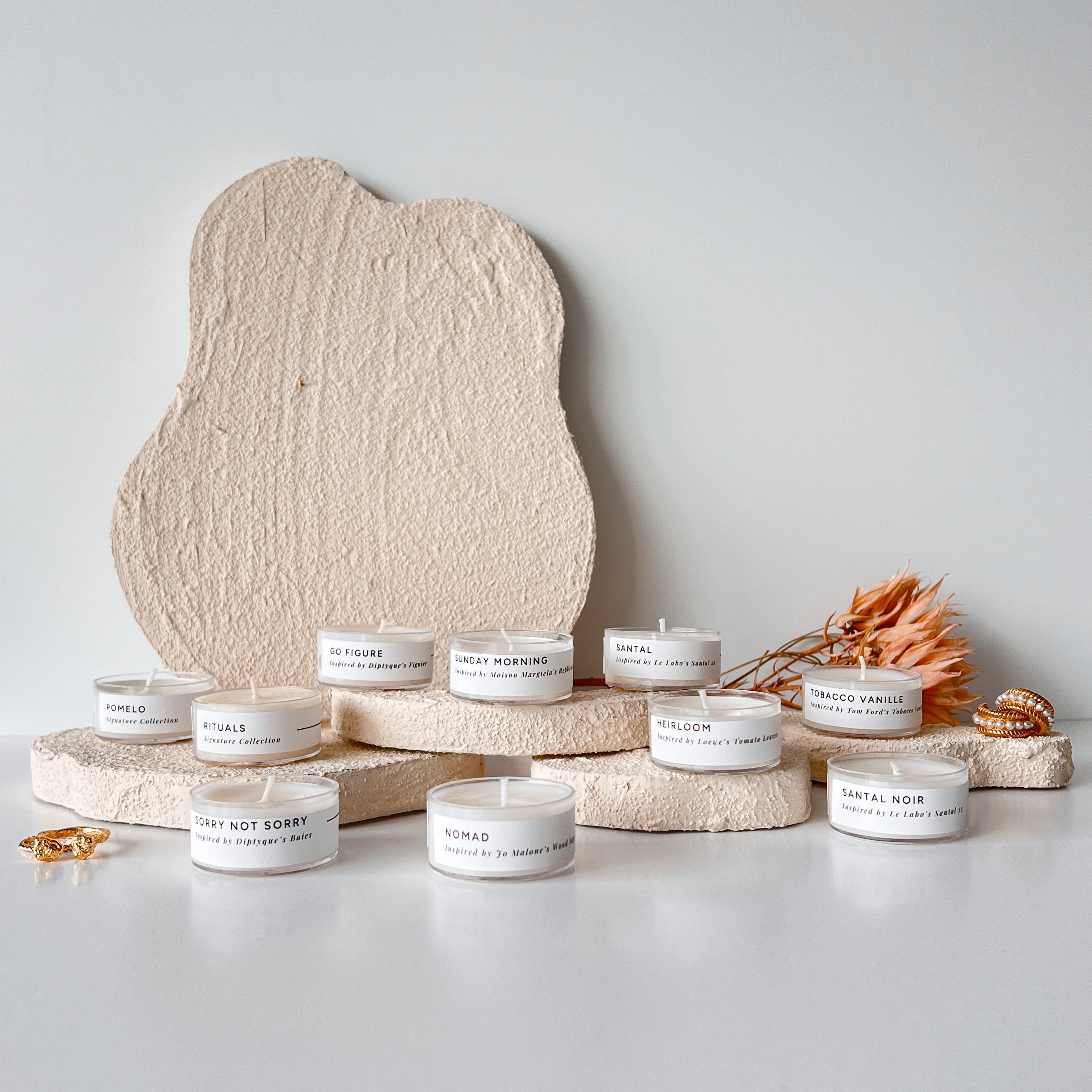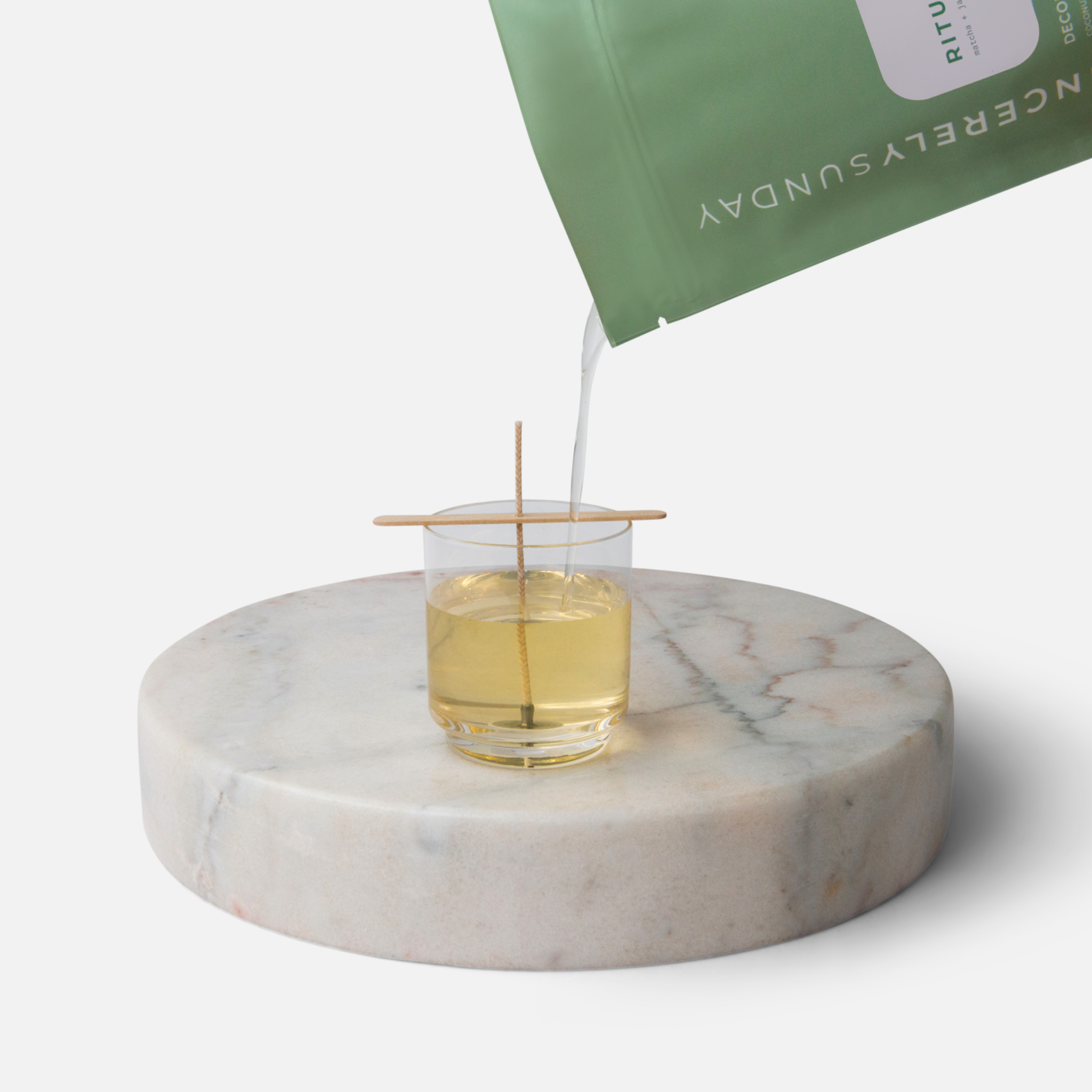Frequently Asked Questions
Candles
We use a proprietary blend of coconut and soy wax, with a touch of refined paraffin, because it aligns with our commitment to creating high-quality, eco-friendly candles. Coconut and soy wax are known for their clean-burning properties, which means less soot in your home and better air quality. These waxes also burn slower, giving you more hours of enjoyment and making them a more sustainable choice.
We included a small amount of refined paraffin after testing showed it significantly improved the strength of the scent throw, enhancing the overall candle experience.
The result? Candles that are not only safer for you and the environment but also fill your space with a rich and lasting aroma.
Coconuts and soybeans each bring unique sustainable benefits, making them a thoughtful foundation for our wax blend:
The Benefits of Coconut Wax
- Absence of pesticides: Coconuts are naturally pest-resistant, requiring fewer harmful chemicals.
- Minimal heavy machinery: Harvesting often relies on manual labor, providing employment opportunities for local farmers.
- No waste: Every part of the coconut is utilized, from water to husk, for food, decor, and dish ware.
- No major deforestation links: Current farming practices don’t significantly contribute to deforestation.
The Benefits of Soy Wax
- Renewable resource: Soybeans are grown annually, making them a readily renewable crop.
- Biodegradable: Soy wax breaks down naturally, reducing its environmental impact.
- Cleaner burning: Produces less soot compared to paraffin wax, contributing to better air quality.
- Supports local farmers: Many soybeans are grown in the U.S., supporting agriculture and the economy.
While both coconut and soy have their challenges—such as the need for sustainable land use as demand grows—we are committed to supporting responsible cultivation methods and minimizing our environmental footprint.
By combining the strengths of these two waxes, we create candles that are not only high-performing but also align with our vision of a more sustainable future.
- Coconut-soy wax with a small amount of refined paraffin
- Fragrance oils: we use a combination of fragrance and essential oils, all of which are non-toxic, dye-free, phthalate-free, and paraben-free
- Cotton wicks woven with paper threads and primed with a wax coating for a consistent and even burn
Our full list of ingredients and materials can be viewed here
Our candles are made to last 50+ hours. The lifespan of your candle will vary depending on how you care for your candle.
Check out our Candle Care guide for more tips and tricks on how to make your candle last as long as possible.
Deconstructed Candles™
Making your own candle has never been easier. It's easy, fun -- best of all, it only takes 5 minutes!
- Select a vessel (approximately 3" wide)
- Melt wax (2 minutes via microwave or 8 minutes via stovetop)
- Center wick
- Pour + Enjoy
For full, step-by-step instructions, view here
The beauty of reusing vessels is the creative freedom to choose one that matches your taste and decor. As a general rule, use a vessel that:
- Is approximately 3" Wide
- Can withstand heat, won't leak, crack, or catch fire.
Ideal Vessels:
• Thick Glass
• Glazed Ceramic
• Sealed Concrete
• Metal Tins
• Metal Tins
Candle Care
There are many ways to clean your vessels, and the best method depends on your preference and what works best for you. Here are some of the easiest and most common techniques:
1. Scoop Method
- Take a spoon and scoop out the leftover wax
- Place wax in a sealed container and save for future use
- Wash vessel with wam soap and water
2. Freezer Method
- Place the candle in the freezer for a few hours or overnight
- The wax will harden and shrink, making it easy to pop out with a spoon or butter knife
3. Boiling Water Method
- Pour boiling water into the vessel, leaving some space at the top
- The wax will melt and float to the surface as it cools; once solidified, you can remove the wax and clean out any residue
4. Oven Method
- Remove all labels
- Preheat your oven to 180°F (82°C), and place the vessel on a baking sheet lined with aluminum foil or parchment paper
- After a few minutes, the wax will melt; pour it out and clean with warm soap and water
For detailed instructions on each method, click here
A candle's lifespan can vary, even for identical ones, depending on how it's cared for. The good news is, with proper care, you can extend its life and enjoy it for as long as possible.
Here are several ways to get the most out of your candle:
- Trim your wick before lighting each candle
- On the first burn, allow the wax to melt across the entire surface
- Recenter your wick as needed
- Don't leave your candle burning all day
Check out our Candle Care guide for more tips and tricks on how to make your candle last as long as possible.
How you extinguish your candle is entirely up to you—there’s no right or wrong way!
That said, the method you choose can affect its performance and cleanliness. Here’s a quick guide to some common options, along with their pros and cons:
1. Blowing Out the Flame
- Pro: Quick and easy—no tools needed!
- Con: Produces smoke and soot, which can leave a lingering smell and dirty the wax.
2. Using a Wick Dipper
- Pro: Extinguishes the flame without smoke for a cleaner burn, removes dirt and debris, and scrapes off excess wax from the sides.
- Con: None :)
3. Using a Wick Snuffer
- Pro: Safely puts out the flame without wax splatter or smoke.
- Con: Can be a bit bulky
You should trim your wick before lighting your candle each time.
If your candle has tunneled, don’t worry! There are a few ways to fix it. Here are some options:
1. Foil Method
- Cut a piece of foil large enough to wrap around the top of your candle, covering the edges of the jar.
- Place the foil around the candle; leave the wick exposed at the center.
- Light the candle and let it burn for 1-2 hours, or until the wax melts evenly across the surface.
- The foil traps heat, helping the wax melt more evenly, filling in the tunnel.
Pro: This method is very easy and does not require any fancy tools
Con: It requires a bit of patience as you need to wrap the candle in foil and let it burn for a while.
2. Wick Dipper Method
- Light your candle and allow it to burn until a wax pool forms.
- Once the wax has melted, use a wick dipper to extinguish the flame.
- After the flame is out, use the dipper to scrape excess wax from the sides into the melted pool.
Pro: Fixes tunneling instantly with no wait time.
Con: Requires a wick dipper, which you'll need to purchase.
Trimming your wick helps you candle look cleaner, last longer, and offers a higher level of safer.
Cleaner Burn: A trimmed wick helps reduce soot and smoke, keeping the air cleaner and your candle looking fresh.
Improved Performance: It ensures a steady, even flame, preventing uneven melting.
Longer Burn Time: A larger flame burns through the candle faster, so by trimming the wick, you slow down the burn time, allowing you to enjoy your candle for longer.
Enhanced Safety: A shorter wick reduces the risk of a high flame or overheated jar, which can cause it to potentially crack or break.





